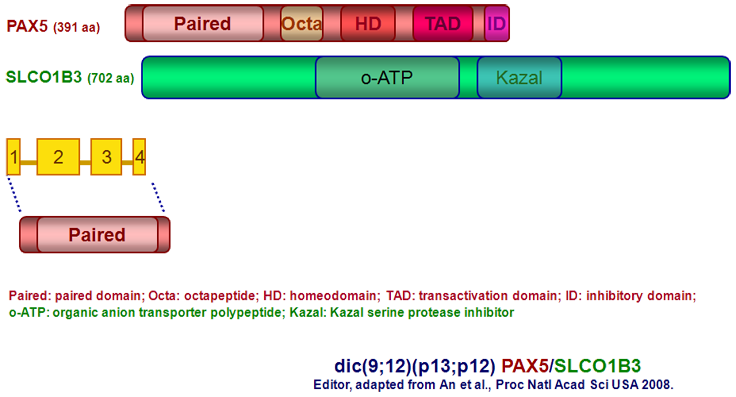dic(9;12)(p13;p12) PAX5/SLCO1B3
2010-02-01 Jean-Loup Huret Affiliation1.Genetics, Dept Medical Information, University of Poitiers, CHU Poitiers Hospital, F-86021 Poitiers, France
Clinics and Pathology
Disease
Phenotype stem cell origin
B-cell precursor ALL.
Epidemiology
One case to date, a 1-year-old girl (An et al., 2008).
Prognosis
No data.
Genes Involved and Proteins
Gene name
PAX5 (paired box gene 5)
Location
9p13.2
Protein description
Lineage-specific transcription factor; recognizes the concensus recognition sequence GNCCANTGAAGCGTGAC, where N is any nucleotide. Involved in B-cell differentiation. Entry of common lymphoid progenitors into the B cell lineage depends on E2A, EBF1, and PAX5; activates B-cell specific genes and repress genes involved in other lineage commitments. Activates the surface cell receptor CD19 and repress FLT3. Pax5 physically interacts with the RAG1/RAG2 complex, and removes the inhibitory signal of the lysine-9-methylated histone H3, and induces V-to-DJ rearrangements. Genes repressed by PAX5 expression in early B cells are restored in their function in mature B cells and plasma cells, and PAX5 repressed (Fuxa et al., 2004; Johnson et al., 2004; Zhang et al., 2006; Cobaleda et al., 2007).
Gene name
SLCO1B3 (solute carrier organic anion transporter family member 1B3)
Location
12p12.2
Protein description
Multi-pass membrane protein. Organic anion transporting polypeptide. Mediates the transport for various molecules such as bile acids, steroids, thyroid hormones, and exogenous drugs. Normally expressed in the basolateral membrane of hepatocytes around the central vein (Hagenbuch and Meier, 2003; Briz et al., 2006).
Result of the Chromosomal Anomaly
Description
Break in PAX5 intron 4. Out of frame fusion of 5 PAX5 - 3 SLCO1B3

Description
The predicted fusion protein contains the DNA binding paired domain of PAX5.
Oncogenesis
Loss of function of PAX5 is likely to be the oncogenic event.
Article Bibliography
| Pubmed ID | Last Year | Title | Authors |
|---|---|---|---|
| 18957548 | 2008 | Variable breakpoints target PAX5 in patients with dicentric chromosomes: a model for the basis of unbalanced translocations in cancer. | An Q et al |
| 16877380 | 2006 | OATP8/1B3-mediated cotransport of bile acids and glutathione: an export pathway for organic anions from hepatocytes? | Briz O et al |
| 17440452 | 2007 | Pax5: the guardian of B cell identity and function. | Cobaleda C et al |
| 15004008 | 2004 | Pax5 induces V-to-DJ rearrangements and locus contraction of the immunoglobulin heavy-chain gene. | Fuxa M et al |
| 12507753 | 2003 | The superfamily of organic anion transporting polypeptides. | Hagenbuch B et al |
| 15258579 | 2004 | B cell-specific loss of histone 3 lysine 9 methylation in the V(H) locus depends on Pax5. | Johnson K et al |
| 16680144 | 2006 | Transcription factor Pax5 (BSAP) transactivates the RAG-mediated V(H)-to-DJ(H) rearrangement of immunoglobulin genes. | Zhang Z et al |
Summary
Fusion gene
PAX5/SLCO1B3 PAX5 (9p13.2) SLCO1B3 (12p12.2) M dic(9;12)(p13;p12)|PAX5/SLCO1B3 PAX5 (9p13.2) SLCO1B3 (12p12.2) TIC
Note
While dic(9;12)(p13;p12) is usually associated with PAX5/ETV6 involvement, one case has been described with SLCO1B3 involvement instead of ETV6.
u0007NOTE See also the paper on dic(9;20)(p11-13;q11).
u0007NOTE See also the paper on dic(9;20)(p11-13;q11).
Citation
Jean-Loup Huret
dic(9;12)(p13;p12) PAX5/SLCO1B3
Atlas Genet Cytogenet Oncol Haematol. 2010-02-01
Online version: http://atlasgeneticsoncology.org/haematological/1555/dic(9;12)(p13;p12)
